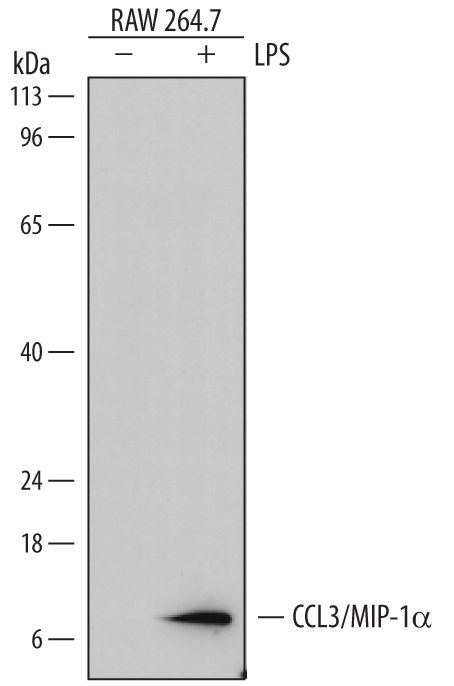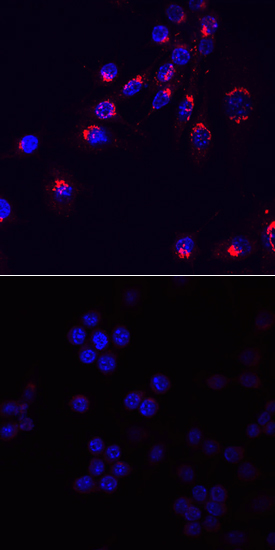Mouse CCL3/MIP-1 alpha Antibody Summary
Applications
Please Note: Optimal dilutions should be determined by each laboratory for each application. General Protocols are available in the Technical Information section on our website.
Scientific Data
 View Larger
View Larger
Detection of Mouse CCL3/MIP‑1 alpha by Western Blot. Western blot shows lysates of RAW 264.7 mouse monocyte/macrophage cell line untreated (-) or treated (+) with 10 µg/mL LPS for 4 hours. PVDF membrane was probed with 1 µg/mL of Rat Anti-Mouse CCL3/MIP-1a Monoclonal Antibody (Catalog # MAB4501) followed by HRP-conjugated Anti-Rat IgG Secondary Antibody (Catalog # HAF005). A specific band was detected for CCL3/MIP-1a at approximately 8 kDa (as indicated). This experiment was conducted under reducing conditions and using Immunoblot Buffer Group 1.
 View Larger
View Larger
CCL3/MIP‑1 alpha in RAW 264.7 Mouse Cell Line. CCL3/MIP-1a was detected in immersion fixed RAW 264.7 mouse monocyte/macrophage cell line stimulated (upper panel) or not (lower panel) with LPS using Rat Anti-Mouse CCL3/MIP-1a Monoclonal Antibody (Catalog # MAB4501) at 10 µg/mL for 3 hours at room temperature. Cells were stained using the NorthernLights™ 557-conjugated Anti-Rat IgG Secondary Antibody (red; Catalog # NL013) and counterstained with DAPI (blue). Specific staining was localized to the cytoplasm of stimulated cells. View our protocol for Fluorescent ICC Staining of Cells on Coverslips.
Reconstitution Calculator
Preparation and Storage
- 12 months from date of receipt, -20 to -70 degreesC as supplied. 1 month, 2 to 8 degreesC under sterile conditions after reconstitution. 6 months, -20 to -70 degreesC under sterile conditions after reconstitution.
Background: CCL3/MIP-1 alpha
CCL3, also known as macrophage inflammatory protein 1 alpha (MIP-1 alpha ) and LD78, is a member of the beta or CC subfamily of chemokines and is closely related to CCL4/MIP-1 beta. Chemokines comprise a large family of small secreted proteins that are involved in immune and inflammatory responses. CCL3 expression can be induced in a variety of hematopoietic cells, fibroblasts, smooth muscle cells, and epithelial cells (1). Mature mouse CCL3 shares 73%, 91%, and 82% amino acid sequence identity with human, rat, and cotton rat CCL3, respectively (2). CCL3 is an approximately 8 kDa chemokine that forms complexes with sulfated proteoglycans (3, 4). In a reversible process, CCL3 associates into noncovalently-linked dimers which then form tetramers and high molecular weight polymers (5, 6). These complexes of CCL3 are protected from proteolytic digestion by insulin degrading enzyme (IDE) which can cleave the monomeric chemokine (6). CCL3 exerts its biological functions through interactions with CCR1, CCR3, and CCR5 (1). It is cleared from the extracellular space by internalization via the decoy chemokine receptor D6 (7). CCL3 promotes the chemoattraction, adhesion to activated vascular endothelium, and cellular activation of many hematopoietic cell types including activated T cells, NK cells, neutrophils, monocytes, immature dendritic cells, and eosinophils (1, 8-10). CCL3 is also known as stem cell inhibitor (SCI) and can inhibit the proliferation of hematopoietic progenitor cells (3). CCL3 bioactivity contributes to tumor metastasis and the inflammatory components of viral infection, rheumatoid arthritis, and hepatitis (11-14), although it also can suppress the replication of HIV (15). CCL3 additionally promotes hyperalgesia by sensitizing sensory neurons to TRPV1-mediated noxious stimulation (16).
- Menten, P. et al. (2002) Cytokine Growth Factor Rev. 13:455.
- Davatelis, G. et al. (1988) J. Exp. Med. 167:1939.
- Graham, G.J. et al. (1990) Nature 344:442.
- Wagner, L. et al. (1998) Nature 391:908.
- Graham, G.J. et al. (1994) J. Biol. Chem. 269:4974.
- Ren, M. et al. (2010) EMBO J. 29:3952.
- Weber, M. et al. (2004) Mol. Biol. Cell 15:2492
- Taub, D.D. et al. (1993) Science 260:355.
- Bernardini, G. et al. (2008) Blood 111:3626.
- Lee, S.C. et al. (2000) J. Immunol. 164:3392.
- Wu, Y. et al. (2008) J. Immunol. 181:6384.
- Cook, D.N. et al. (1995) Science 269:1583.
- Chintalacharuvu, S.R. et al. (2005) Immunol. Lett. 100:202.
- Ajuebor, M.N. et al. (2004) Eur. J. Immunol. 34:2907.
- Cocchi, F. et al. (1995) Science 270:1811.
- Zhang, N. et al. (2005) Proc. Natl. Acad. Sci. 102:4536.
Product Datasheets
Citation for Mouse CCL3/MIP-1 alpha Antibody
R&D Systems personnel manually curate a database that contains references using R&D Systems products. The data collected includes not only links to publications in PubMed, but also provides information about sample types, species, and experimental conditions.
1 Citation: Showing 1 - 1
-
Therapeutic Effects of Human Mesenchymal Stem Cells in a Mouse Model of Cerebellar Ataxia with Neuroinflammation
Authors: Y Nam, D Yoon, J Hong, MS Kim, TY Lee, KS Kim, HW Lee, K Suk, SR Kim
J Clin Med, 2020-11-13;9(11):.
Species: Mouse
Sample Types: Cell Lysates, Whole Tissue
Applications: IHC, Western Blot
FAQs
No product specific FAQs exist for this product, however you may
View all Antibody FAQsReviews for Mouse CCL3/MIP-1 alpha Antibody
There are currently no reviews for this product. Be the first to review Mouse CCL3/MIP-1 alpha Antibody and earn rewards!
Have you used Mouse CCL3/MIP-1 alpha Antibody?
Submit a review and receive an Amazon gift card.
$25/€18/£15/$25CAN/¥75 Yuan/¥2500 Yen for a review with an image
$10/€7/£6/$10 CAD/¥70 Yuan/¥1110 Yen for a review without an image




